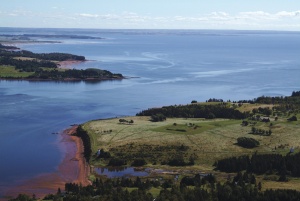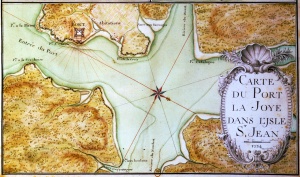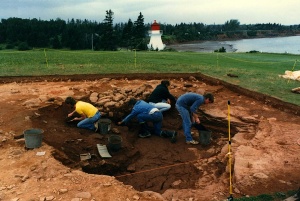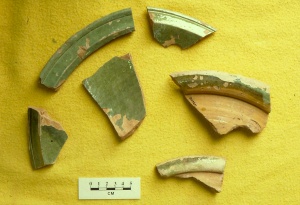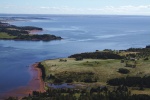Port-la-Joye – Fort Amherst: A Colonial Outpost in an Island Setting
par MacDonald, Monica
Port-la-Joye – Fort Amherst National Historic Site of Canada is located near Rocky Point off Route 19 on the south shore of Queen’s County, Prince Edward Island. Visitors to the site will encounter the grass-covered earthworks of Fort Amherst, erected by the British in 1758, as well as an indication of the location of some of the structures associated with the earlier Port-la-Joye – a French colonial outpost and one of the Island’s first permanent European settlements. This includes the excavated foundation of the house belonging to Michel Haché dit Gallant and his wife, Anne Cormier, who were among the first Acadians to settle on Prince Edward Island.
Article disponible en français : Port-la-Joye – Fort Amherst, à l’Île-du-Prince-Édouard
National Historic Designation
The Historic Sites and Monuments Board of Canada (HSMBC) designated Port-la-Joye – Fort Amherst as being of national historic significance for several reasons (NOTE 1). From 1720 to 1768 the site served first the French and then the British as the Island’s seat of government and port of entry. Port-la-Joye was also an important French colonial outpost, a place where French leaders met regularly with their Mi’kmaw counterparts to renew alliances, and overall a significant site of conflict in the struggle between France and Britain for control of North America (NOTE 2). Finally, the site was the location on the Island where in 1758 the British assembled and forcibly transported to France the (mostly) Acadian population.
A French and Acadian Endeavour
The early history of Port-la-Joye – Fort Amherst is best understood within the larger geopolitical and cultural context of the Atlantic region. Before the turn of the eighteenth century, what is now known as Prince Edward Island was occupied only by the Mi’kmaq. They called the small island Epekwitk, meaning “cradled on the waves,” and considered it part of a much larger territory that included today’s Maritime Provinces. This area was known to them as Mi’kma’ki.
The coming of the French changed forever the situation of the Mi’kmaq as the sole permanent inhabitants of Epekwitk. It began in 1719 when the Regent of King Louis XV granted to Louis Hyacinthe Castel, Comte de Saint Pierre, exclusive trading, fishing and other rights to Île Saint-Jean (the French name for Prince Edward Island). In exchange for this royal grant the Comte and his Compagnie de l’île Saint-Jean would establish a colony. Though it was a private venture, the company officials would be directly subordinate to the governor of Île Royale at Louisbourg (NOTE 3).
The first ships arriving at Île Saint-Jean from Rochefort, France, in 1720 carried supplies, settlers, fishermen, a garrison of thirty and commandant Robert-David Gotteville de Belile of the Compagnies Franches de la Marine. They chose a location with a deep and sheltered harbour, and one that afforded a wide view of the entrance channel to the larger basin and mouth of the Rivière du Nord Est, the waterway leading to the north of the Island. Strategically, this was important given the ever-present possibility at the time of renewed conflict with the British. Through the terms of the 1713 Treaty of Utrecht, the French had lost control of Acadia (peninsular Nova Scotia) to the British, but retained Île Saint-Jean, Île Royale (Cape Breton), and certain fishing rights along part of the Newfoundland coastline.
The group named the site Port-la-Joye and set to work erecting the buildings necessary for an outpost and settlement. These buildings soon included living quarters for the commandant (and possibly some officers) and chaplain, barracks for the soldiers, as well as a chapel, bakery and storehouse (NOTE 4). Outside of this area were the houses of the settlers, including some who had arrived that first year from Nova Scotia. One belonged to Michel Haché dit Gallant and his wife, Anne Cormier. The Gallants and their family came from Beaubassin and were among the first Acadians to settle permanently on Île Saint-Jean (NOTE 5). Other French and Acadians settled elsewhere on the Island, most notably on the north shore at Havre St. Pierre.
After four years the Comte de Saint Pierre’s company failed and many of the inhabitants of Port-la-Joye departed. The Governor at Louisbourg withdrew the garrison and commandant. Several of the (mostly Acadian) families, including the Gallants, stayed on and fended for themselves. The future of the fledgling colony looked grim. Eventually, however, the Governor authorized for it a new garrison and commandant and in 1726, Jacques d’Espiet de Pensens and twenty-five to thirty men arrived from Louisbourg. Port-la-Joye became a colony of the crown, though the Company’s grant was not officially revoked until 1730.
The outpost survived passably until 1744. That year, war was declared between Britain and France and the Governor at Louisbourg recalled the garrison. The settlers moved inland. In the summer of 1745, a force of Anglo-Americans sailed from New England and besieged and captured Louisbourg. A detachment of that force then headed for Île Saint-Jean. They first attacked and burned Trois Rivières, another settlement on the eastern shore of the Island, before landing at the deserted Port-la-Joye and setting it to the torch as well. But a small French-led force arrived and confronted the attackers. After the fighting both retreated, the French to Quebec and the Anglo-Americans to Louisbourg, now in their possession.
Port-la-Joye essentially lay in ruins. When in 1748 peace came once again between the two nations, the French officially reclaimed Île Royale and Île Saint-Jean. The Governor of Canada at Quebec sent a new detachment to Île Saint-Jean under commandant Claude Elisabeth Denys de Bonnaventure to re-establish Port-la-Joye. The peace was tenuous, though this was most obvious in Nova Scotia. The Acadians there were being pressured by the growing militarization and British settlement of the colony, as well as by continued efforts by British authorities to have them take an unqualified oath of allegiance. French authorities pressured them too, especially to move to French-held territory. By the end of 1754, Acadian immigration to Île Saint-Jean had increased its total population from about 735 in 1748 to approximately 3000 (NOTE 6).
The End of Port-la-Joye and the Deportation
The promise of Port-la-Joye began to fade once again with yet another renewal of the hostilities between Britain and France. In 1755, before war was even officially declared, the British began to implement in its entirety their program of deporting all French and Acadians living in Nova Scotia to the Anglo-American colonies or to England. Many who escaped the ships made their way to Île Saint-Jean. With this influx, over the next three years the total French and Acadian civilian population of the Island grew to over 4000 (NOTE 7).
With the second siege and capitulation of Louisbourg in July of 1758, the French and Acadians living on Île Saint-Jean themselves became subject to the Deportation. From the ruins of Louisbourg the British Lieutenant-Colonel Andrew Rollo and his regiment sailed to Port-la-Joye to take possession of the Island. Then commandant, Gabriel Rousseau de Villejouin, was compelled to surrender. The rounding up of the inhabitants began. Roughly 1100 of the population eluded the British, some by hiding but most by fleeing the Island altogether (NOTE 8). In all, however, the British deported from the site around 3100 (mostly) Acadian civilians to France (NOTE 9). At least half never made it to their destination – succumbing to shipwreck, poor conditions and disease – and more died soon after arrival as a result of their ordeal (NOTE 10). This was the highest death rate in the series of deportations conducted by the British between 1755 and 1762.
From Fort to Farm
The British victory was decisive and French control of Île Saint-Jean came to end. The British renamed their possession St. John’s Island. They renamed Port-la-Joye as well, after the commander of the land forces at Louisbourg, Major-General Jeffrey Amherst, and built a modest fort slightly higher on the same bluff where the French had located their collection of buildings. For ten years Fort Amherst continued to serve as the Island’s seat of government and port of entry. In 1768 the garrison withdrew from the fort and moved to Charlottetown, chosen as the site for the new capital by Surveyor-General Samuel Holland.
Fort Amherst and the physical evidence of its troubled past began to decline. Holland had been tasked with surveying the entire Island into townships or lots and the one that encompassed Fort Amherst he numbered Lot 65. The specific acreage of the Fort Amherst lot was reserved for military purposes, though it would never see military action. The lot was leased in the ensuing years largely for agricultural purposes. By 1914 it was in the possession of John Hyndman, its last civilian landholder. In 1959 the Province of Prince Edward Island (so named in 1799) purchased the Fort Amherst property on behalf of the Government of Canada for the purposes of creating a national historic park (NOTE 11).
Evolution of a National Historic Site
The story of Port-la-Joye – Fort Amherst as a national historic site of Canada (NOTE 12) reflects an evolution in the understanding and interpretation of its complex past. In May 1958 the HSMBC recommended that “Fort Amherst (Port la Joie)” be declared of national historic significance and that the site was suitable for the creation of a national historic park. A standard plaque was issued for “Fort Amherst.” Later that year, in a discussion on the possible creation of another national historic park for the Island at Brudenell Point (formerly Trois Rivières), the Board noted the greater importance of Port la Joie as “the capital of the Island during the French regime and the scene of transition from that regime to English rule.”
The official reasons for the designation of Fort Amherst as a place of national historic significance were eventually created from these and other Board minutes and recommendations. Thus, the site became recognized for its role from 1720 to 1770 as the Island seat of government and port of entry, and as a colonial outpost in the struggle between the French and the British. In 1985, in order to better commemorate the French and Acadian occupation, an Order-in-Council was issued to change the name to Fort Amherst/Port la Joye. In 2003, in a HSMBC discussion on national historic sites with dual names that reflect separate historical aspects, the Board referred to the site as Port-la-Joye – Fort Amherst.
Over the years the Parks Canada Agency, its principal stakeholders and other partners, increasingly emphasized the connection of Port-la-Joye – Fort Amherst to important themes other than those for which it was officially recognized. In 1965 descendants of Michel Haché-Gallant and Anne Cormier placed a marker at the site in honour of their ancestors. In 2008 the Commission pour la commémoration internationale de l'Odyssée acadienne et du Grand Dérangement erected a monument on the grounds in order to signify the connection of the site to the Acadian Deportation. That year the HSMBC expanded the reasons for the site’s designation to include this fact. The expanded reasons also include the role of Port-la-Joye as one of two locations in the Atlantic region where Mi’kmaw leaders met regularly with French authorities to renew alliances. At the same time the Board amended the terminal date of the site’s significance from 1770 to the more precise date of 1768.
Without the historical and archaeological research of the Parks Canada Agency and its stakeholders, partners and others interested in its past, much of what we know about Port-la-Joye – Fort Amherst may not have come to light. And because there are few obvious vestiges at the site and no reconstruction, without their interpretive efforts this history might tax the imagination. Port-la-Joye – Fort Amherst will no doubt continue to evolve as a national historic site and with its many fascinating elements, continue to represent an important chapter in Prince Edward Island and Canadian history.
Monica MacDonald
Parks Canada
Additional DocumentsSome documents require an additional plugin to be consulted
Images
-
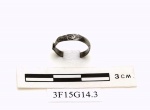 Silver ring from the
Silver ring from the
Gallant propert... -
 A 1734 map of Port-la
A 1734 map of Port-la
-Joye and area,... -
 Croquis de 1734 prése
Croquis de 1734 prése
ntant un projet... -
 Earthenware jug from
Earthenware jug from
the Gallant pro...
-
 Archaeological excava
Archaeological excava
tion of part of... -
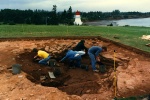 Archaeological excava
Archaeological excava
tion of the Gal... -
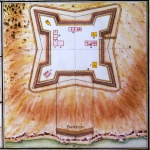 The proposed fort, in
The proposed fort, in
a 1734 map of ... -
 French medallion, Por
French medallion, Por
t-la-Joye
-
 Acadian Odyssey monum
Acadian Odyssey monum
ent at Port-la-... -
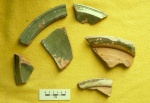 Pieces of a Saintonge
Pieces of a Saintonge
coarse earthen... -
 Artistic rendering of
Artistic rendering of
the 1745 attac... -
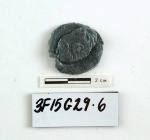 French bale seal, Por
French bale seal, Por
t-la-Joye
Catégories
Notes
1. Minutes of the Historic Sites and Monuments Board, December 2008.
2. The other location was at or near present-day St. Peter’s on Cape Breton Island; they may have also met in the 1750s at Chapel Island. The meetings ceased by 1755 due to the wartime situation. A.J.B. (John) Johnston, “Port-la-Joye – Fort Amherst National Historic Site of Canada: Proposal to Revise the Commemorative Intent,” Historic Sites and Monuments Board of Canada 2008-74 (2008): 5 n.3, 8.
3. For details of this relationship see Barbara Schmeisser, “Building a Colonial Outpost on Ile St. Jean: Port La Joye, 1720-1758,” Parks Canada Agency, Atlantic Service Centre (2000).
4. Schmeisser, “Building a Colonial Outpost on Ile St. Jean: Port La Joye, 1720-1758,” 2-3.
5. On the Gallants and the archaeological remains of their property see Rob Ferguson, “The Search for Port La Joye: Archaeology at Île Saint-Jean’s First French Settlement,” Island Magazine, 27 (Spring/Summer 1990): 3-8.
6. Stephen A. White, “The True Number of the Acadians,” in Du Grand Dérangement à la Deportation: Nouvelles perspectives historiques, dir. Ronnie-Gilles LeBlanc (Moncton: Chaire d’études acadiennes, Université du Moncton, 2005), 39, 55.
7. Christine Boucher (and Ronnie-Gilles LeBlanc, personal communication) cite Stephen A. White as evaluating the population at 4100, while other researchers put the number higher, for example Earle Lockerby (4600). Stephen White on the Odyssée acadienne et du Grand Dérangement monument at Port-la-Joye and on the website of the Société nationale de l’Acadie; Earle Lockerby, Deportation of the Prince Edward Island Acadians (Halifax: Nimbus, 2008), [66-]68, both cited in Boucher, “La Déportation des habitants de L’Île Saint-Jean,” Historic Sites and Monuments Board 2010-22 (2010): 3, n.10.
8. Ronnie-Gilles LeBlanc, personal communication; Johnston, “Port-la-Joye – Fort Amherst National Historic Site of Canada: Proposal to Revise the Commemorative Intent,” 8; Earle Lockerby estimates this number as high as 1600. Lockerby, Deportation of the Prince Edward Island Acadians, 66-68.
9. Lockerby, Deportation of the Prince Edward Island Acadians, 68.
10. Lockerby, Deportation of the Prince Edward Island Acadians, 67-70.
11. On the late eighteenth and nineteenth century development of the site see Schmeisser, “Building a Colonial Outpost on Ile St. Jean: Port La Joye, 1720-1758,” 129-134.
12. On the following section see the Minutes of the Historic Sites and Monuments Board, especially May/November 1958, May 1961, June 1981, November 1985, December 2003 and December 2008. For a summary of the development of the HSMBC designation of PLJFA as a National Historic Park/Site see Johnston, “Port-la-Joye – Fort Amherst National Historic Site of Canada: Proposal to Revise the Commemorative Intent.”

